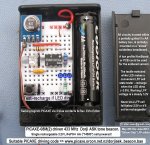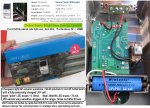ZOR: Expensive? Most security firms have great stacks of "used" 12V SLAs that are considered mere scrap. These come from critical situations (banks etc) where the prospect of early failure can't be tolerated. Replacement is hence made as often as every 2 years!
Call by such a firm,perhaps with a few cooling ales on Friday afternoon, & they'll probably say help yourself- they otherwise may have to pay for their disposal. Most are classic 7Ah, but oddballs abound too.
Such rescued SLAs are still usually good for years of further light duty service. While teaching here in Wellington (NZ) I used to salvage stacks of them for "educational" use, often near overloading the car. Stan.
EXTRA:Chains of AA cells (either primary alkaline or secondary NiCd/NiMH) in series are prone to leakage,condensation & dirt on the terminals/contacts!! ARGH... This is a significant reason why modern outdoor solar security lamps no longer use multiple NiCd/NiMH. Most of us are long familiar with "tap the e-device" to reseat poor battery contacts! For 12V you'd also annoyingly need 8 x 1.5V or 10 x 1.2V, while LiFePO4 would give this with just 4 cells (4 x 3.2V=12.8V). Fewer cells mean a more compact enclosure too.
With modern "3V" circuitry 3 x 1.2V NiCd/NiMH (=3.6V) can be replaced with just a single ~3.6V LiIon/LiPoly or (arguably better) robust leakproof 3.2V LiFePO4. The latter additionally offers far longer cycle life (1000s rather than 100s) & negligible self discharge. Although still quite new (even compared with Li-Ion), single AA LiFePO4 solar charged systems (security & wireless etc) I've had running outdoors for several years haven't missed a beat.


